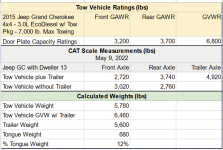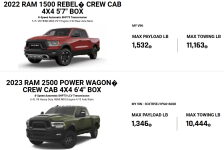This is partially true. Yes, the button turns on the inverter, but it does NOT control the charger (I think; please, anyone, correct me if I'm wrong on any of this).
Noob clarification for
@Riviot. The big Renogy box under the bed is an inverter/charger combo, which has three main functions:
- CHARGER
- The charger takes shore power (generator, campground power, or plugged in at home) and uses it to charge the battery bank
- In order to allow power to come from the shore, you need to turn the MAIN breaker on the breaker panel on and the charger will do its thing (pushing the Renogy button doesn't matter)
- Note: It comes pre-set to handle AGM battery banks, and if you ever upgrade to lithium, you will want to change the setting so it keeps the batteries at the proper voltage
- INVERTER
- The inverter takes DC power and inverts it to AC power (essentially battery power (12V) to wall-plug power (120V))
- In order to turn on the inverter, you have to push the little round Renogy button you were looking at before, and you'll hear a beep and some whirring, but the 120V outlets in the trailer still won't be on
- In order to make the outlets "live", you need to flip the INVERTER breaker on the breaker on and you can use your curling iron
- Note: you do not have to have the MAIN breaker flipped on to run the INVERTER function if you're not hooked up to shore power; it will take the power from the battery and invert it to 120V through just the INVERTER breaker.
- PASS-THROUGH POWER
- It's silly to go through the trouble for the CHARGER to take shore power (120V), convert it battery power (12V), just to have the INVERTER invert it back to outlet power (120V)
- Your Renogy inverter/charger thinks so, too, because it's smart (smart enough, anyway)
- IF you have shore power hooked up, and both your MAIN and INVERTER breakers on, the inverter/charger actually passes the 120V power directly through to your outlets, bypassing both the CHARGER and INVERTER functions
- This is also how you run your A/C (and why there's a separate A/C breaker on your breaker panel); it's intended to be run on PASS-THROUGH POWER so it doesn't tax your battery bank (the draw would kill your AGM bank in a matter of minutes)
You'll also notice there's another panel that says Renogy which is for your Solar Controller. This is a completely separate device, with its own settings, that takes solar power (photovoltaic energy) and charges your battery bank. That is always on (assuming there's sunlight). The two charging systems each have individual battery monitors, so when the batteries are full, neither of them will overcharge your bank, and when your batteries are low, they will try to recharge your batteries through whichever source of power (shore or sunlight) is available. They both have the same goal, but are completely clueless that the other one exists.
Oh, and if your trailer is equipped (mine is not yet), there's yet a third source of power to charge the batteries through that Anderson plug on the tongue. If your truck is also wired up (wire running from the battery or alternator back near the hitch receiver, with an Anderson plug on the end), the trailer can pull power from the alternator on the truck that is charging its own battery. The truck alternator is designed to work with AGM batteries (your trucks main battery isn't lithium), so it won't overcharge your bank. That same Anderson plug could be used for a portable solar panel (
@S J I'm certain
Zamp makes Anderson adapters), but you'll need to ensure that your panel either has its own controller so it doesn't overcharge your bank, or that the trailer Anderson plug is running through the onboard solar controller (which is how you would manage the voltage from the truck if you changed to Lithium). So now I think I've answered both of your questions, maybe too thoroughly.
That was a lot, and probably way more than you were looking for, but I hope it helps. And I hope it's right. Someone will chime in if I'm a liar; they always do.




